In February 2018, I undertook a targeted survey with taxonomist Bob Harwood for the vulnerable geophyte Typhonium praetermissum on the Gunn Point peninsula, approximately 30 km north east of the Darwin CBD. In addition, we also searched for the vine Operculina turpethum. And we found both of them!
Operculina turpethum (L.) Silva Manso (Convolvulaceae)
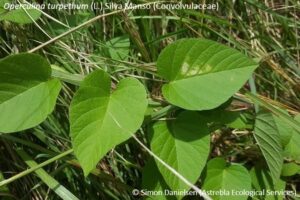
Operculina turpethum is a twining vine growing to 4 m or more, recorded from various locations (mostly coastal and sub-coastal) across northern Australia, but primarily it is known from South East Asia. It had been recorded in 2000 from grassland at the rear of a low sand dune at Gunn Point, and our task was to determine if it was still present. Operculina turpethum is listed as near threatened in the NT.
 We quickly located it, growing in the same grassland location as in 2000 (possibly from the same tuber). It was not flowering, however its presence in the same location as a previous confirmed record, and its conspicuously flanged/winged stems, suggested that is it highly likely to be O. turpethum.
We quickly located it, growing in the same grassland location as in 2000 (possibly from the same tuber). It was not flowering, however its presence in the same location as a previous confirmed record, and its conspicuously flanged/winged stems, suggested that is it highly likely to be O. turpethum.
This species was originally described by Linnaeus in 1753 as Convolvulus turpethum, but was split from that genus by Silva Manso in 1836.
Typhonium praetermissum A. Hay (Araceae)
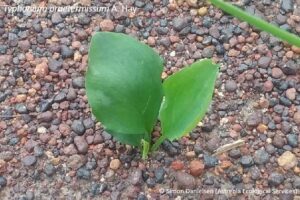 Typhonium praetermissum is a relatively cryptic perennial geophyte (i.e. a predominately subterranean herb) endemic to the Darwin/Litchfield area. It flowers and fruits in November and December, and appears to produce leaves only during the wet season, after which they quickly deteriorate and the plant disappears beneath the soil. The flowers are very delicate and exude an apparently unpleasant odour, but are quickly destroyed by ongoing wet season downpours, having a life of 1-3 days.
Typhonium praetermissum is a relatively cryptic perennial geophyte (i.e. a predominately subterranean herb) endemic to the Darwin/Litchfield area. It flowers and fruits in November and December, and appears to produce leaves only during the wet season, after which they quickly deteriorate and the plant disappears beneath the soil. The flowers are very delicate and exude an apparently unpleasant odour, but are quickly destroyed by ongoing wet season downpours, having a life of 1-3 days.
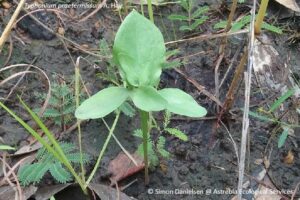 There are some major difficulties in locating and accurately identifying Typhonium spp.. Flowers are generally required to key to species, however these are rarely encountered. In addition, most species have leaves that display extreme morphological variations (as can be seen in the accompanying photos), making even tentative ID difficult.
There are some major difficulties in locating and accurately identifying Typhonium spp.. Flowers are generally required to key to species, however these are rarely encountered. In addition, most species have leaves that display extreme morphological variations (as can be seen in the accompanying photos), making even tentative ID difficult.
 However, Dr Matthew Barrett of the WA Dept. of Biodiversity, Conservation and Attractions has developed a DNA barcoding technique that allows accurate and unambiguous identification to species of sterile material. Consequently, representative collections of leaf material were made from within the population of Typhonium individuals observed during our survey at Gunn Point and send to Dr Barrett for analysis and identification.
However, Dr Matthew Barrett of the WA Dept. of Biodiversity, Conservation and Attractions has developed a DNA barcoding technique that allows accurate and unambiguous identification to species of sterile material. Consequently, representative collections of leaf material were made from within the population of Typhonium individuals observed during our survey at Gunn Point and send to Dr Barrett for analysis and identification.
 As a result, the identification of the majority of the population observed to T. praetermissum was possible. In addition, a small number of T. johnsonianum were also confirmed present. Interestingly, of the many hundreds of individuals of both species observed during the surveys, only one individual had fruit – all of the remainder were sterile.
As a result, the identification of the majority of the population observed to T. praetermissum was possible. In addition, a small number of T. johnsonianum were also confirmed present. Interestingly, of the many hundreds of individuals of both species observed during the surveys, only one individual had fruit – all of the remainder were sterile.
The population of T. praetermissum at this Gunn Point site was predominately located on lower run-off slopes in low woodland and woodland with a mixed species dominance, including Corymbia polysciada, Melaleuca viridiflora, Erythrophleum chlorostachys, Xanthostemon paradoxus, Lophostemon lactifluus and Gardenia megasperma. The ground layer was generally tall (to 2 m) and dense, dominated by perennial grasses and numerous herbs.
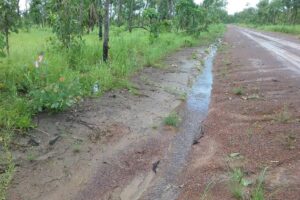 An interesting observation was that T. praetermissum was often present on disturbed surfaces, including spoon drains that are graded annually, and an old gravel pit.
An interesting observation was that T. praetermissum was often present on disturbed surfaces, including spoon drains that are graded annually, and an old gravel pit.
 In the photo to the left, Bob Harwood is pointing out a population of nearly 100 individuals we observed in a large gravel pit beside the main road.
In the photo to the left, Bob Harwood is pointing out a population of nearly 100 individuals we observed in a large gravel pit beside the main road.
T. praetermissum leaves are generally less than 5 cm long and those in the photo were almost all about 1-2 cm long, so they can be very difficult to spot among tall grass – but they are down there, believe me!
Typhonium johnsonianum A. Hay & S. Taylor (Araceae)
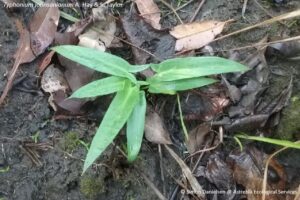 This species is very similar to T. praetermissum, but is less well known, being listed as data deficient in the NT. It has been recorded from the Alligator River floodplain, Kakadu National Park, and from the Humpty Doo and Noonamah areas. This survey represents the first collection from the Gunn Point area – as such, a range extension of approximately 30 km, which is relatively significant for a locally endemic plant with such a small range.
This species is very similar to T. praetermissum, but is less well known, being listed as data deficient in the NT. It has been recorded from the Alligator River floodplain, Kakadu National Park, and from the Humpty Doo and Noonamah areas. This survey represents the first collection from the Gunn Point area – as such, a range extension of approximately 30 km, which is relatively significant for a locally endemic plant with such a small range.
 In general, T. johnsonianum displays less leaf-form variation than T. praetermissum – the leaves were invariably narrow triangular with a distinctive sagittate to hastate base, and a relatively short petiole. Some plants are more lanceolate, being cuneate to rounded at the base and lacking auricles.
In general, T. johnsonianum displays less leaf-form variation than T. praetermissum – the leaves were invariably narrow triangular with a distinctive sagittate to hastate base, and a relatively short petiole. Some plants are more lanceolate, being cuneate to rounded at the base and lacking auricles.

Can you be more specific about the content of your article? After reading it, I still have some doubts. Hope you can help me.
Your article helped me a lot, is there any more related content? Thanks!
Thank you for your sharing. I am worried that I lack creative ideas. It is your article that makes me full of hope. Thank you. But, I have a question, can you help me? https://accounts.binance.com/ro/register?ref=V3MG69RO
Can you be more specific about the content of your article? After reading it, I still have some doubts. Hope you can help me.
I don’t think the title of your article matches the content lol. Just kidding, mainly because I had some doubts after reading the article.
Your article helped me a lot, is there any more related content? Thanks!
Your point of view caught my eye and was very interesting. Thanks. I have a question for you.
Thanks for sharing. I read many of your blog posts, cool, your blog is very good.
Your point of view caught my eye and was very interesting. Thanks. I have a question for you.
Your point of view caught my eye and was very interesting. Thanks. I have a question for you.
Your article helped me a lot, is there any more related content? Thanks!
Your article helped me a lot, is there any more related content? Thanks!
Can you be more specific about the content of your article? After reading it, I still have some doubts. Hope you can help me.
https://shorturl.fm/6rgpc
https://shorturl.fm/gqo9L
https://shorturl.fm/PRf1v
https://shorturl.fm/Y8kLF
https://shorturl.fm/oc5tG
https://shorturl.fm/0LUjF
https://shorturl.fm/froey
https://shorturl.fm/Sjevw
https://shorturl.fm/Xxnic
Your article helped me a lot, is there any more related content? Thanks!
https://shorturl.fm/n9vsW
Thank you for your sharing. I am worried that I lack creative ideas. It is your article that makes me full of hope. Thank you. But, I have a question, can you help me?
I don’t think the title of your article matches the content lol. Just kidding, mainly because I had some doubts after reading the article. https://www.binance.info/register?ref=P9L9FQKY
https://shorturl.fm/12R0p
https://shorturl.fm/R2okm
I don’t think the title of your article matches the content lol. Just kidding, mainly because I had some doubts after reading the article. https://www.binance.info/en/register?ref=JHQQKNKN
https://shorturl.fm/zXmdC
https://shorturl.fm/5qXSJ
https://shorturl.fm/MoLX7
https://shorturl.fm/pNX2C
I don’t think the title of your article matches the content lol. Just kidding, mainly because I had some doubts after reading the article. https://www.binance.com/ru/register?ref=V3MG69RO
Thanks for sharing. I read many of your blog posts, cool, your blog is very good.
https://shorturl.fm/oJjfZ
https://shorturl.fm/7TP5j
https://shorturl.fm/bAVY5
Your point of view caught my eye and was very interesting. Thanks. I have a question for you. https://www.binance.info/en-ZA/register?ref=JHQQKNKN
https://shorturl.fm/CGmNo
https://shorturl.fm/zAPvm
https://shorturl.fm/9zlk6
https://shorturl.fm/Al8jt
https://shorturl.fm/iBaPM
https://shorturl.fm/Hafgh
https://shorturl.fm/ec3SU
Thank you for your sharing. I am worried that I lack creative ideas. It is your article that makes me full of hope. Thank you. But, I have a question, can you help me? https://accounts.binance.info/en-IN/register-person?ref=UM6SMJM3
https://shorturl.fm/31gjB
https://shorturl.fm/pAGl4
https://shorturl.fm/zcAOe
https://shorturl.fm/D6sNi
Your point of view caught my eye and was very interesting. Thanks. I have a question for you.
https://shorturl.fm/XoJTS
https://shorturl.fm/dsZ0a
https://shorturl.fm/jOxe8
https://shorturl.fm/7neDC
Thanks for sharing. I read many of your blog posts, cool, your blog is very good.
https://shorturl.fm/HtCWK
https://shorturl.fm/2N4Ii
Your article helped me a lot, is there any more related content? Thanks!
https://shorturl.fm/lrKqB
https://shorturl.fm/VrkFC
Your point of view caught my eye and was very interesting. Thanks. I have a question for you.
https://shorturl.fm/eZzOP
Your article helped me a lot, is there any more related content? Thanks!
https://shorturl.fm/lZj2p
https://shorturl.fm/iHjRY
https://shorturl.fm/aciYP
https://shorturl.fm/wSfeM
Thank you for your sharing. I am worried that I lack creative ideas. It is your article that makes me full of hope. Thank you. But, I have a question, can you help me?
https://shorturl.fm/xxqvq
https://shorturl.fm/AuMEJ
https://shorturl.fm/prDMA
https://shorturl.fm/kHBfr
https://shorturl.fm/t00lL
https://shorturl.fm/DBwLO
https://shorturl.fm/x9lrx
https://shorturl.fm/N7sf5
https://shorturl.fm/xgeok
Your article helped me a lot, is there any more related content? Thanks!
https://shorturl.fm/dlpbz
https://shorturl.fm/ztcgc
Thank you for your sharing. I am worried that I lack creative ideas. It is your article that makes me full of hope. Thank you. But, I have a question, can you help me? https://www.binance.com/en-IN/register?ref=UM6SMJM3
https://shorturl.fm/wIR1A
https://shorturl.fm/H8Lkt
I don’t think the title of your article matches the content lol. Just kidding, mainly because I had some doubts after reading the article. https://www.binance.com/register?ref=P9L9FQKY
https://shorturl.fm/QCFsW
Thanks for sharing. I read many of your blog posts, cool, your blog is very good. https://www.binance.info/fr-AF/register?ref=UT2YTZSU
I don’t think the title of your article matches the content lol. Just kidding, mainly because I had some doubts after reading the article.
https://shorturl.fm/3X1ZO
https://shorturl.fm/RqYz3
W88xlm, I’ve seen it floating around. Decent variety, not much to complain about. Solid enough if you’re already familiar with the W88 brand. Not a bad choice, overall. w88xlm
https://shorturl.fm/xUxzd
https://shorturl.fm/DEbJl
Can you be more specific about the content of your article? After reading it, I still have some doubts. Hope you can help me. https://www.binance.info/register?ref=IXBIAFVY
https://shorturl.fm/X9PJL
https://shorturl.fm/GMZbX
Cara, Vbetbrasil is my go-to spot for sports betting. The odds are great, and they always pay out quickly. Plus, the site is super easy to navigate, even on my phone. Definitely worth checking out! Learn more here: vbetbrasil
https://shorturl.fm/zoZS4
I don’t think the title of your article matches the content lol. Just kidding, mainly because I had some doubts after reading the article.